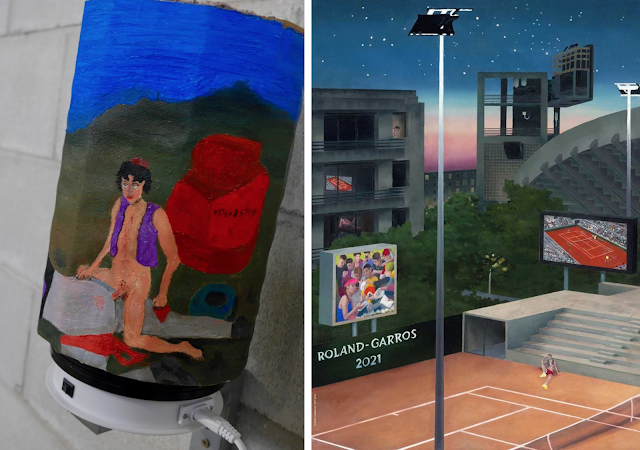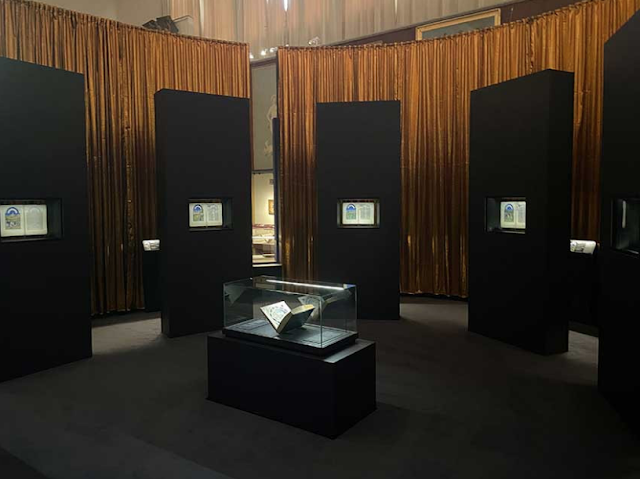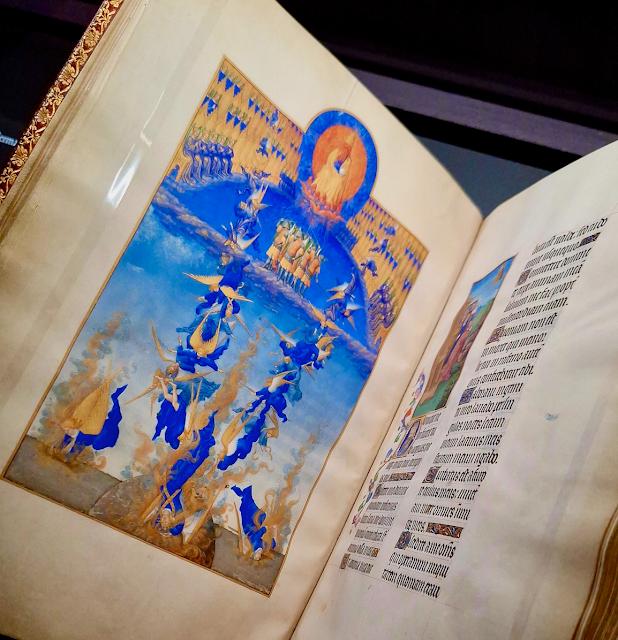Les Très Riches Heures du Duc de Berry at Chantilly
This week I made the trip out to Chantilly where, in the Jeu de Paume, the Condé museum is showing, quite exceptionally, the calendar folios of the Duc de Berry's Très Riches Heures. These twelve double-page spreads have just been restored, which explains why it was possible now to display them individually, in specially-made, air-conditioned cases, before they are bound back into the book and shut away, like Sleeping Beauty (the original Disney version of which they are said to have influenced), for the next hundred years, maybe more. The museum is marketing the show as a once-in-a-lifetime experience.
According to museum director Mathieu Deldicque, who also curated the exhibition:
'This manuscript was already famous in the Middle Ages. By putting it back into context, we can better understand what makes it the most ambitious, where it came from, who commissioned it, and why, from the 15th century onwards, it had such a profound influence on the arts, manuscripts, painting, sculpture, etc. In other words, we have iconic works [on display] here, and in this manuscript, the most important iconic work of the Middle Ages.'
(Source: podcast on France Culture, July 21 2025, translated from French).
As the above quotation implies, the exhibition starts by focusing on Jean de Berry, 'son, brother, and uncle of kings,' as Deldicque puts it in the podcast, even to the extent of fetching and installing his tomb effigy, carved by Jean de Cambrai, from Bourges, nearly 300 Km away.
 |
| Photo: DRAC Centre-Val de Loire |
Before visitors actually reach the calendar pages, countless illuminated manuscripts help them understand the many and varied iconographic and stylistic sources that fed into the work of the Limbourg (or Limburg or Lymborch) brothers and their successors. The three started work in 1411, but all died - perhaps of the plague - the same year as their patron, in 1416; the manuscript was only completed 70 years later (about 40 years before work began on another great illuminated manuscript I've posted about on this blog, the Shahnameh of Shah Tahmasp).
The next section, still before reaching the twelve pages, shows the immediate, widespread influence the Très Riches Heures had on the arts of the time and in later years. I personally wished it had extended further, not just to Walt Disney, and the medieval world as seen in pop and video-game culture in general, but also to its ongoing influence on contemporary artists of the likes of Jean Claracq or Adrian Mabileau Ebrahimi Tajadod. But perhaps that's a subject that would be more satisfactorily covered in a separate exhibition. In 2021, the V&A's Epic Iran ended with a couple of rooms of modern and contemporary Iranian art, but the selection was necessarily too small to give an adequate overview.
 |
L.: Adrian Mabileau Ebrahimi Tajadod, untitled. R.: Jean Claracq, poster for the French tennis open, Roland-Garros. |
The calendar folios themselves are displayed in a dark room which takes its chapel-like floor-plan from the layout of the monthly paintings: an arch (the 'apse') over a rectangle (the 'nave'). The columnar display cases mark the curve of the 'apse', while the precious book itself is on show in a horizontal case in the middle. On the day I visited, it was open at the page of the falling angels.
The images are of course familiar to us all, in my case from the time I was first captivated by some details reproduced in a book about the history of costume, at my junior school. I must have been about eight or nine. Later I'd find, and often leaf through, a complete facsimile of the illustrations in the library at my grammar school. The museum has, incidentally, a collection of the various facsimile editions, displayed at the end.
Seeing the originals after so many years is a moving experience. Why the pages must absolutely be folded back into their binding and hidden away even from researchers, when the exhibition shows, or appears to show, that they can be displayed under carefully-controlled conditions, was not made explicit - unless I missed it. Perhaps the slightest ray of light presents a danger. At any rate, in the long and detailed French Wikipedia entry devoted to the Très Riches Heures, which looks as if it's been thoroughly updated in time for this exhibition, manuscript expert Christopher de Hamel is quoted as saying it's 'easier to meet the Pope or the President of the United States than touch the Très Riches Heures.'
My own three photos from the exhibition are here on this blog post. I didn't take any more, as better images of the illuminations are easy to find anywhere. A good place to begin is the museum's own browsable, high-resolution digital facsimile:
https://les-tres-riches-heures.chateaudechantilly.fr/
Finally, here's a link to the exhibition website:
https://chateaudechantilly.fr/en/evenement/les-tres-riches-heures-du-duc-de-berry/
 |
| Installation view. Photo: © Château de Chantilly, 2025 |





Comments
Post a Comment